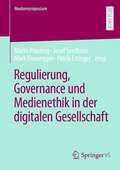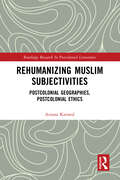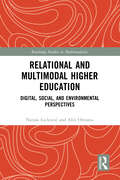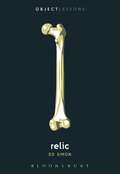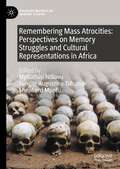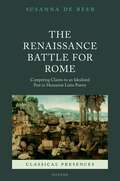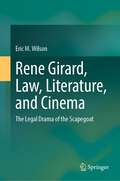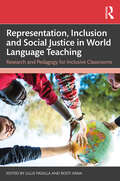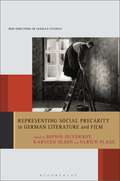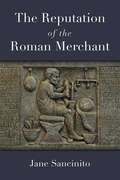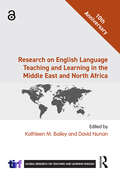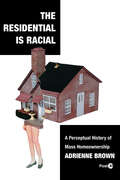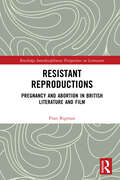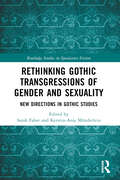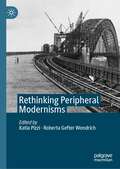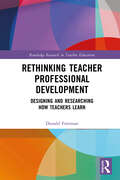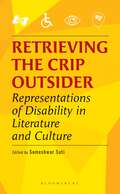- Table View
- List View
Regulierung, Governance und Medienethik in der digitalen Gesellschaft (Mediensymposium)
by Marlis Prinzing Josef Seethaler Mark Eisenegger Patrik EttingerUnsere stark von netzbasierten und global verflochtenen Machtstrukturen geprägten Gesellschaften offenbaren angesichts globaler Herausforderungen und Krisen (u.a. menschengemachter Klimawandel; Corona-Pandemie; Big Data und Überwachung) ungelöste Fragen zu Ethik und Regulierung der öffentlichen Kommunikation, zu deren Klärung die Kommunikations- und Medienwissenschaft einiges beitragen kann. Die Pandemie beispielsweise ist unter anderem eine kommunikative Herausforderung, an der sich die prägende Bedeutung eines ethischen Kompasses für die Orientierung und Qualität von Journalismus erweist. Für demokratische Gesellschaften bleibt der öffentliche Diskurs zwar konstitutiv, aber zugleich gewinnt die Fähigkeit, mit Dissonanz und Streit umzugehen, immer mehr an Bedeutung. Die Beiträge des Bands befassen sich mit Theoriebildung und Normsetzung, Regulierungs- und Governancestrukturen, Regulierungsinhalten und Regulierungsherausforderungen, sowie mit Überlegungen zu einer Neujustierung der Kommunikations- und Medienethik.
Rehumanizing Muslim Subjectivities: Postcolonial Geographies, Postcolonial Ethics (Routledge Research in Postcolonial Literatures)
by Aroosa KanwalRehumanizing Muslim Subjectivities: Postcolonial Geographies, Postcolonial Ethics is a timely and urgent monograph, allowing us to imagine what it feels like to be the victim of genocide, abuse, dehumanization, torture and violence, something which many Muslims in Palestine, Kashmir, Pakistan, Myanmar, Syria, Iraq and China have to endure. Most importantly, the book emphasizes the continued relevance of creative literature’s potential to intervene in and transform our understanding of a conceptual and political field, as well as advanced technologies of power and domination. The book makes a substantial theoretical contribution by drawing on wide-ranging angles and dimensions of contemporary drone warfare and its related catastrophes, postcolonial ethics in relation to the thanatopolitics of slow violence, dehumanization and the politics of death. Against the backdrop of such institutionalized and diverse acts of violence committed against Muslim communities, I call the postcolonial Muslim world ‘geographies of dehumanization’. The book investigates how ongoing legacies of contemporary forms of injustice and denial of subjecthood are represented, staged and challenged in a range of postcolonial anglophone Muslim texts, thereby questioning the idea of postcolonial ethics. One of the selling points of this book is the chapters on fictional representations by Muslim Myanmar and Uyghur writers as, to the best of my knowledge, no critical work or single authored book is available on Myanmar and Uyghur literature to date.
Rehumanizing Muslim Subjectivities: Postcolonial Geographies, Postcolonial Ethics (Routledge Research in Postcolonial Literatures)
by Aroosa KanwalRehumanizing Muslim Subjectivities: Postcolonial Geographies, Postcolonial Ethics is a timely and urgent monograph, allowing us to imagine what it feels like to be the victim of genocide, abuse, dehumanization, torture and violence, something which many Muslims in Palestine, Kashmir, Pakistan, Myanmar, Syria, Iraq and China have to endure. Most importantly, the book emphasizes the continued relevance of creative literature’s potential to intervene in and transform our understanding of a conceptual and political field, as well as advanced technologies of power and domination. The book makes a substantial theoretical contribution by drawing on wide-ranging angles and dimensions of contemporary drone warfare and its related catastrophes, postcolonial ethics in relation to the thanatopolitics of slow violence, dehumanization and the politics of death. Against the backdrop of such institutionalized and diverse acts of violence committed against Muslim communities, I call the postcolonial Muslim world ‘geographies of dehumanization’. The book investigates how ongoing legacies of contemporary forms of injustice and denial of subjecthood are represented, staged and challenged in a range of postcolonial anglophone Muslim texts, thereby questioning the idea of postcolonial ethics. One of the selling points of this book is the chapters on fictional representations by Muslim Myanmar and Uyghur writers as, to the best of my knowledge, no critical work or single authored book is available on Myanmar and Uyghur literature to date.
Relational and Multimodal Higher Education: Digital, Social and Environmental Perspectives (Routledge Studies in Multimodality)
by Nataša Lacković Alin OlteanuThis book proposes a relational turn in higher education by conceptualizing knowledge and pedagogy as relational and multimodal, analyzed through three dimensions of relationality: social, technological, and environmental. The volume draws on interdisciplinary approaches that make a case for integrating these interconnected and distinct dimensions in higher education theory and practice. Its novelty lies in combining such a variety of perspectives with Peircean semiotics to explore what it means to learn and live relationally. It emphasizes the importance of critical reflection, rooted in an environmental understanding of knowledge and digital media. This approach integrates materiality, place, and space in higher education, positioning caring, critically reflective and imaginative interactions and interpretations as central for knowledge growth. The volume features practical case studies of relational pedagogy through dialogues with diverse higher education practitioners, which embrace expression and creation through more than one dominant modality of communication and being. The book envisions students and educators as relational agents, with relational awareness and responsibility, aware of their multimodal identities. It highlights how a relational multimodal paradigm can serve as a way forward for universities to address global challenges concerning social, (post)digital, and environmental futures. This innovative book will be of interest to scholars, students, teachers, and policymakers in higher education, semiotics and multimodality, as well as postdigital, sociomaterial and futures studies.
Relational and Multimodal Higher Education: Digital, Social and Environmental Perspectives (Routledge Studies in Multimodality)
by Nataša Lacković Alin OlteanuThis book proposes a relational turn in higher education by conceptualizing knowledge and pedagogy as relational and multimodal, analyzed through three dimensions of relationality: social, technological, and environmental. The volume draws on interdisciplinary approaches that make a case for integrating these interconnected and distinct dimensions in higher education theory and practice. Its novelty lies in combining such a variety of perspectives with Peircean semiotics to explore what it means to learn and live relationally. It emphasizes the importance of critical reflection, rooted in an environmental understanding of knowledge and digital media. This approach integrates materiality, place, and space in higher education, positioning caring, critically reflective and imaginative interactions and interpretations as central for knowledge growth. The volume features practical case studies of relational pedagogy through dialogues with diverse higher education practitioners, which embrace expression and creation through more than one dominant modality of communication and being. The book envisions students and educators as relational agents, with relational awareness and responsibility, aware of their multimodal identities. It highlights how a relational multimodal paradigm can serve as a way forward for universities to address global challenges concerning social, (post)digital, and environmental futures. This innovative book will be of interest to scholars, students, teachers, and policymakers in higher education, semiotics and multimodality, as well as postdigital, sociomaterial and futures studies.
Relic (Object Lessons)
by Dr. Ed SimonObject Lessons is a series of short, beautifully designed books about the hidden lives of ordinary things.Every culture, every religion, every era has enshrined otherwise regular objects with a significance which stretches beyond their literal importance. Whether the bone of a Catholic martyr, the tooth of a Buddhist lama, or the cloak of a Sufi saint, relics are material conduits to the immaterial world. Yet relics aren't just a feature of religion. The exact same sense of the transcendent animates objects of political, historical, and cultural significance.From Abraham Lincoln's death mask to Vladimir Lenin's embalmed corpse, Emily Dickinson's envelopes to Jimi Hendrix's guitar pick, relics are the objects which the faithful understand as being more than just objects. Material things of sacred importance, relics are indicative of a culture's deepest values. Object Lessons is published in partnership with an essay series in The Atlantic.
Remembering Mass Atrocities: Perspectives on Memory Struggles and Cultural Representations in Africa (Palgrave Macmillan Memory Studies)
by Mphathisi Ndlovu Lungile Augustine Tshuma Shepherd MpofuThis book explores how popular cultural artifacts, literary texts, commemorative practices and other forms of remembrances are used to convey, transmit and contest memories of mass atrocities in the Global South. Some of these historical atrocities took place during the Cold war. As such, this book unpacks the influence or role of the global powers in conflict in the Global South. Contributors are grappling with a number of issues such as the politics of memorialization, memory conflicts, exhumations, reburials, historical dialogue, peacebuilding and social healing, memory activism, visual representation, transgenerational transmission of memories, and identity politics.
The Renaissance Battle for Rome: Competing Claims to an Idealized Past in Humanist Latin Poetry (Classical Presences)
by Dr Susanna de BeerThe Renaissance Battle for Rome examines the rhetorical battle fought simultaneously between a wide variety of parties (individuals, groups, authorities) seeking prestige or legitimacy through the legacy of ancient Rome—a battle over the question of whose claims to this legacy were most legitimate. Distinguishing four domains—power, morality, cityscape and literature—in which ancient Rome represented a particularly powerful example, this book traces the contours of this rhetorical battle across Renaissance Europe, based on a broad selection of Humanist Latin Poetry. It shows how humanist poets negotiated different claims on behalf of others and themselves in their work, acting both as "spin doctors" and "new Romans", while also undermining competing claims to this same idealized past. By so doing this book not only offers a new understanding of several aspects of the Renaissance that are usually considered separately, but ultimately allows us to understand Renaissance culture as a constant negotiation between appropriating and contesting the idea and ideal of "Rome."
Rene Girard, Law, Literature, and Cinema: The Legal Drama of the Scapegoat
by Eric M. WilsonThis book is the first monograph to critically evaluate the work of the literary scholar René Girard from the perspectives of Law and Literature and Law and Film Studies, two of the most multidisciplinary branches of critical legal theory. The central thesis is that Girard’s theory of the scapegoat mechanism provides a wholly new and original means of re-conceptualizing the nature of judicial modernity, which is the belief that modern Law constitutes an internally coherent and exclusively secular form of rationality. The book argues that it is the archaic scapegoat mechanism – the reconciliation of the community through the direction of unified violence against a single victim – that actually works best in explaining all of the outstanding issues of Law and Literature in both of its sub-forms: law-as-literature (the analysis of legal language and practice exemplified by literacy texts) and law-in-literature (the exploration of issues in legaltheory through the fictitious form of the novel). The book will provide readers with: (i) a useful introduction to the most important elements of the work of René Girard; (ii) a greater awareness of the ‘hidden’ nature of legal culture and reasoning within a post-secular age; and (iii) a new understanding of the ‘subversive’ (or ‘enlightening‘) nature of some of the most iconic works on Law in both Literature and Cinema, media which by their nature allow for the expression of truths repressed by formal legal discourse.
Representation, Inclusion and Social Justice in World Language Teaching: Research and Pedagogy for Inclusive Classrooms
by Lillie Padilla Rosti VanaThis volume introduces teaching methodologies for improving and incorporating representation, inclusion and social justice perspectives in the world language curriculum. Chapters present state-of-the-art research and cover many different language contexts, including French, Spanish, Mandarin, and Portuguese. Authors discuss difficult and hot topics, such as Critical Language Awareness, Critical Race Theory, non-binary language use in gendered languages, culturally sustaining curriculum, teaching heritage language speakers, and more. Ideal for graduate courses, students, and scholars in world language education, the volume offers new pathways and strategies for promoting diversity and equity in the classroom.
Representation, Inclusion and Social Justice in World Language Teaching: Research and Pedagogy for Inclusive Classrooms
This volume introduces teaching methodologies for improving and incorporating representation, inclusion and social justice perspectives in the world language curriculum. Chapters present state-of-the-art research and cover many different language contexts, including French, Spanish, Mandarin, and Portuguese. Authors discuss difficult and hot topics, such as Critical Language Awareness, Critical Race Theory, non-binary language use in gendered languages, culturally sustaining curriculum, teaching heritage language speakers, and more. Ideal for graduate courses, students, and scholars in world language education, the volume offers new pathways and strategies for promoting diversity and equity in the classroom.
Representing Social Precarity in German Literature and Film (New Directions in German Studies)
by Sophie Duvernoy, Karsten Olson, and Ulrich PlassUsing Germany as a national case study, this volume examines the historical genesis of precarity, its evolution from 19th-century industrial modernity to the present, and its reflections and reconfigurations in artistic production, in particular with relation to work, gender, and sexuality.“Precarity is everywhere now,” sociologist Pierre Bourdieu declared almost thirty years ago. Not only declining middle-class standards of living, but also debt, drug addiction, housing and food insecurity, depression, and “deaths of despair” are now being recognized as symptoms of the downward pull of social precarity. Although these and similar ills have been attributed to neoliberal policies of deregulation, privatization, and willful neglect of the common good, precarization has accompanied the booms and busts of industrial modernity from its beginnings. Representing Social Precarity in German Literature and Film explores how German and Austrian literature, film, and social history have engaged with social precarity, from the period of Romanticism and early industrialization to the present. The chapters in this volume deal with precarity as both an objective phenomenon reflected in literary and filmic representations and as a subjective phenomenon that gives these representations their particular shape. Representing Social Precarity in German Literature and Film opens new critical perspectives on diverse forms of lived precarity and their creative manifestations by reflecting on the history of capitalist modernity from the vantage points of weakness, vulnerability, marginality, impoverishment, and otherness.
The Reputation of the Roman Merchant (Law And Society In The Ancient World)
by Jane SancinitoRoman merchants, artisans, and service providers faced substantial prejudice. Contemporary authors labeled them greedy, while the Roman on the street accused merchants of lying and cheating. Legally and socially, merchants were kept at arm’s length from respectable society. Yet merchants were common figures in daily life, populating densely packed cities and traveling around the Mediterranean. The Reputation of the Roman Merchant focuses on the strategies retailers, craftsmen, and many other workers used to succeed, examining how they developed good reputations despite the stigma associated with their work. In a novel approach, blending social and economic history, The Reputation of the Roman Merchant considers how reputation worked as an informal institution, establishing and reinforcing traditional Roman norms while lowering the cost of doing business for individual workers. From histories and novels to inscriptions and art, this volume identifies common reputation strategies, explores how points of pride and personal accomplishments were shared with others, and explains responses to merchant activities on the small-scale. The book concludes that merchants invested heavily in their reputations as a way to set themselves apart from common, negative stereotypes without admitting that there was anything shameful about the work they did.
Research on English Language Teaching and Learning in the Middle East and North Africa (Global Research on Teaching and Learning English)
The tenth volume in the TIRF-Routledge series, this book features research on the teaching and learning of English in the Middle East and North Africa (MENA). With chapters written by TIRF Doctoral Dissertation Grant awardees and internationally known scholars, the volume addresses contemporary challenges and considerations to teaching English in the MENA context. With empirical research covering a wide range of under-studied contexts, this book provides important insights and future directions to improve research and instruction. Offering up-to-date research at the primary, secondary, and post-secondary levels, this volume is an essential resource for language education programs and pre-service teachers.Chapter 7 of this book is freely available as a downloadable Open Access PDF at http://www.taylorfrancis.com under a Creative Commons [Attribution-Non Commercial-No Derivatives (CC-BY-NC-ND)] 4.0 license.
Research on English Language Teaching and Learning in the Middle East and North Africa (Global Research on Teaching and Learning English)
by Kathleen M. Bailey David NunanThe tenth volume in the TIRF-Routledge series, this book features research on the teaching and learning of English in the Middle East and North Africa (MENA). With chapters written by TIRF Doctoral Dissertation Grant awardees and internationally known scholars, the volume addresses contemporary challenges and considerations to teaching English in the MENA context. With empirical research covering a wide range of under-studied contexts, this book provides important insights and future directions to improve research and instruction. Offering up-to-date research at the primary, secondary, and post-secondary levels, this volume is an essential resource for language education programs and pre-service teachers.Chapter 7 of this book is freely available as a downloadable Open Access PDF at http://www.taylorfrancis.com under a Creative Commons [Attribution-Non Commercial-No Derivatives (CC-BY-NC-ND)] 4.0 license.
The Residential Is Racial: A Perceptual History of Mass Homeownership (Post*45)
by Adrienne BrownHousing experts and activists have long described the foundational role race has played in the creation of mass homeownership. This book insistently tracks the inverse: the role of mass homeownership in changing the definition, perception, and value of race. In The Residential is Racial Adrienne Brown reveals how mass homeownership remade the rubrics of race, from the early cases realtors made for homeownership's necessity to white survival through to the 1968 Fair Housing Act. Reading real estate archives and appraisal textbooks alongside literary works by F. Scott Fitzgerald, John Steinbeck, Lorraine Hansberry, Richard Wright, Gwendolyn Brooks, James Baldwin, Ralph Ellison, John Cheever, and Thomas Pynchon, Brown goes beyond merely identifying the discriminatory mechanisms that the real estate industry used to forestall black homeownership. Rather, she reveals that redlining and other forms of racial discrimination are perceptual modes, changing what it means to sense race and assign it value. Resituating residential discrimination as a key moment within the history of perception and aesthetics as well as of policy, demography, and democracy, we get an even more expansive picture of both its origins and its impacts. This book discovers that the racial honing of perception on the block—seeing race like a bureaucrat, an appraiser, and a homeowner—has become central to the functioning of the residential itself.
The Residential Is Racial: A Perceptual History of Mass Homeownership (Post*45)
by Adrienne BrownHousing experts and activists have long described the foundational role race has played in the creation of mass homeownership. This book insistently tracks the inverse: the role of mass homeownership in changing the definition, perception, and value of race. In The Residential is Racial Adrienne Brown reveals how mass homeownership remade the rubrics of race, from the early cases realtors made for homeownership's necessity to white survival through to the 1968 Fair Housing Act. Reading real estate archives and appraisal textbooks alongside literary works by F. Scott Fitzgerald, John Steinbeck, Lorraine Hansberry, Richard Wright, Gwendolyn Brooks, James Baldwin, Ralph Ellison, John Cheever, and Thomas Pynchon, Brown goes beyond merely identifying the discriminatory mechanisms that the real estate industry used to forestall black homeownership. Rather, she reveals that redlining and other forms of racial discrimination are perceptual modes, changing what it means to sense race and assign it value. Resituating residential discrimination as a key moment within the history of perception and aesthetics as well as of policy, demography, and democracy, we get an even more expansive picture of both its origins and its impacts. This book discovers that the racial honing of perception on the block—seeing race like a bureaucrat, an appraiser, and a homeowner—has become central to the functioning of the residential itself.
Resistant Reproductions: Pregnancy and Abortion in British Literature and Film (Routledge Interdisciplinary Perspectives on Literature)
by Fran BigmanResistant Reproductions asks why narratives of pregnancy and abortion emerged in the early twentieth century and what kinds of stories these narratives conveyed. Is it only once pregnancy becomes plannable that it becomes a story worth telling? Abortion is often considered resistant and feminist, while pregnancy is considered domestic and conventional. How can readings of literary narratives challenge this reductive binary?Resistant Reproductions, the first book-length study of both pregnancy and abortion in British culture, addresses these questions by examining pregnancy narratives, including abortion narratives, in British fiction and film from 1907 to 1967. Fiction became a way for writers to explore what new possibilities of reproductive control would mean for the individual, yet there was also much anxiety about who would have control: individuals or the state. While exploring intimate personal experiences of pregnancy and abortion, Resistant Reproductions also asks how literary narratives used reproductive plots to address political issues of gender, class, and eugenics.
Resistant Reproductions: Pregnancy and Abortion in British Literature and Film (Routledge Interdisciplinary Perspectives on Literature)
by Fran BigmanResistant Reproductions asks why narratives of pregnancy and abortion emerged in the early twentieth century and what kinds of stories these narratives conveyed. Is it only once pregnancy becomes plannable that it becomes a story worth telling? Abortion is often considered resistant and feminist, while pregnancy is considered domestic and conventional. How can readings of literary narratives challenge this reductive binary?Resistant Reproductions, the first book-length study of both pregnancy and abortion in British culture, addresses these questions by examining pregnancy narratives, including abortion narratives, in British fiction and film from 1907 to 1967. Fiction became a way for writers to explore what new possibilities of reproductive control would mean for the individual, yet there was also much anxiety about who would have control: individuals or the state. While exploring intimate personal experiences of pregnancy and abortion, Resistant Reproductions also asks how literary narratives used reproductive plots to address political issues of gender, class, and eugenics.
Rethinking Gothic Transgressions of Gender and Sexuality: New Directions in Gothic Studies (Routledge Studies in Speculative Fiction)
by Sarah Faber Kerstin-Anja MünderleinFrom early examples of queer representation in mainstream media to present-day dissolutions of the human-nature boundary, the Gothic is always concerned with delineating and transgressing the norms that regulate society and speak to our collective fears and anxieties.This volume examines British and American Gothic texts from four centuries and diverse media – including novels, films, podcasts, and games – in case studies which outline the central relationship between the Gothic and transgression, particularly gender(ed) and sexual transgression. This relationship is both crucial and constantly shifting, ever in the process of renegotiation, as transgression defines the Gothic and society redefines transgression. The case studies draw on a combination of well-studied and under-studied texts in order to arrive at a more comprehensive picture of transgression in the Gothic.Pointing the way forward in Gothic Studies, this original and nuanced combination of gendered, Ecogothic, queer, and media critical approaches addresses established and new scholars of the Gothic alike.
Rethinking Gothic Transgressions of Gender and Sexuality: New Directions in Gothic Studies (Routledge Studies in Speculative Fiction)
From early examples of queer representation in mainstream media to present-day dissolutions of the human-nature boundary, the Gothic is always concerned with delineating and transgressing the norms that regulate society and speak to our collective fears and anxieties.This volume examines British and American Gothic texts from four centuries and diverse media – including novels, films, podcasts, and games – in case studies which outline the central relationship between the Gothic and transgression, particularly gender(ed) and sexual transgression. This relationship is both crucial and constantly shifting, ever in the process of renegotiation, as transgression defines the Gothic and society redefines transgression. The case studies draw on a combination of well-studied and under-studied texts in order to arrive at a more comprehensive picture of transgression in the Gothic.Pointing the way forward in Gothic Studies, this original and nuanced combination of gendered, Ecogothic, queer, and media critical approaches addresses established and new scholars of the Gothic alike.
Rethinking Peripheral Modernisms
by Katia Pizzi Roberta Gefter WondrichThis collection of essays reappraises the contributions made by modernist movements from regions generally regarded as peripheral or semi-peripheral to a global aesthetic of Modernism. It particularly focuses on European semi-peripheries, combining theoretical chapters and individual case studies to examine the cultural and aesthetic complexities of so-called peripheral modernisms. Contributing to research on the ‘transnational turn’ in New Modernist Studies, the volume takes recent scholarship on postcolonial modernisms one step further by exploring a broader geopolitical expanse than the (formerly) colonised regions under global capitalism. It highlights the local and translocal specificities of modernist movements from regions such as Eastern and Central Europe and the Mediterranean to offer new insights into the concept of global modernism.
Rethinking Teacher Professional Development: Designing and Researching How Teachers Learn (Routledge Research in Teacher Education)
by Donald FreemanThis book presents a new set of ideas to challenge established thinking and to guide researching and designing teacher professional development. Grounded in the work of the Learning4Teaching Project which documented public-sector teachers’ experiences and learning from professional development in three countries, the volume presents a sociomaterial perspective on teacher sensemaking. This teacher-centered perspective disputes the "conventional calculus" in which teachers learn content that they apply in their classrooms. Part I outlines conventional issues in how teacher learning and professional development have been conceptualized and studied; Part II introduces a new group of concepts that rethink these assumptions; and Part III offers important insights to inform professional development across disciplines, cultures, and contexts. Written by a leading international teacher educator in an accessible style that incorporates visual representations and project data, the book will appeal to practitioners, scholars, and researchers who design and research how teachers learn in professional development.
Rethinking Teacher Professional Development: Designing and Researching How Teachers Learn (Routledge Research in Teacher Education)
by Donald FreemanThis book presents a new set of ideas to challenge established thinking and to guide researching and designing teacher professional development. Grounded in the work of the Learning4Teaching Project which documented public-sector teachers’ experiences and learning from professional development in three countries, the volume presents a sociomaterial perspective on teacher sensemaking. This teacher-centered perspective disputes the "conventional calculus" in which teachers learn content that they apply in their classrooms. Part I outlines conventional issues in how teacher learning and professional development have been conceptualized and studied; Part II introduces a new group of concepts that rethink these assumptions; and Part III offers important insights to inform professional development across disciplines, cultures, and contexts. Written by a leading international teacher educator in an accessible style that incorporates visual representations and project data, the book will appeal to practitioners, scholars, and researchers who design and research how teachers learn in professional development.
Retrieving the Crip Outsider: Representations of Disability in Literature and Culture
by Someshwar SatiWhy are abnormal figures at the heart of literary canon and what do they tell us about the society that writes and circulates these stories? This book studies the constitution of disability and discusses concepts of corporeal difference that are socio-historically rooted in the Indian cultural milieu.The volume aims at looking at the central issue of the various aspects of disability representation, the impact of these representations on the materially embodied experience of disablement, the political imperatives shaping the narratives of corporeal difference, and the influences of highly particularised local cultural context on the constitution of epistemic and discursive notions of corporeality.The volume follows three routes of inquiry: How do we find 'disability' in texts or, what are 'disability texts'? How do we read concepts historically using literary and cultural texts and what would a similar study of the Indian context reveal? How do we study culturally distinct ways of narrating bodyminds? These questions will be answered through a discussion of representation histories of the abnormal informed by histories of disease conditions and its representations, with the aim of developing ways of thinking and talking about concepts of corporeal difference that are socio-culturally and socio-historically located away from the western context and to explore the intersections between gender, caste, religion, sexuality, class and disability.
